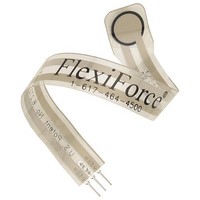INTRODUCTION
This manual describes how to use FlexiForce’s Single Serial Button (SSB). These sensors are ideal for designers, engineers
and researchers who need to measure forces without disturbing the dynamics of their test. The FlexiForce sensors can be
used to measure both static and dynamic forces (up to 1000 lbf), and are thin enough to enable non-intrusive measure-
ment.
SSB sensors use a resistive-based technology. The application of a force to an active sensor results in a change in the
resistance of the sensing element in inverse proportion to the force applied.
OVERVIEW
Sensor Construction
The SSB sensor is an ultra-thin (0.005”), flexible printed circuit. It is 0.55” (14 mm.) wide and 8” (203 mm.) in
length, from the end of the connector to the tip of the sensor. Sensors are available with specificied maximum forces of 1,
25, 100, 500, and 1000 lbf
are constructed of two layers of substrate, such as a polyester film. On each layer, a conductive material (silver) is ap-
plied, followed by a layer of pressure-sensitive ink. Adhesive is then used to laminate the two layers of substrate together
to form the sensor. The ’active sensing area’ is defined by the silver circle on top of the pressure-sensitive ink. Silver
extends from the sensing area to the connectors at the other end of the sensor, forming the conductive leads. SSB sensors
are terminated with a 3-pin Berg Clincher
outer pins of the connector are active and the center pin is inactive.
Application
The sensor acts as a resistor in an electrical circuit. When the sensor is unloaded, it’s resistance is very high. When a
force is applied to the sensor, this resistance decreases. This resistance can be read by connecting an ohmmeter to the
outer two pins of the sensor connector and applying a force to the sensing area.
There are many ways to integrate the SSB sensor into an application. One way is to incorporate it into a force-to-voltage
circuit. A means of calibration must then be established to convert the output into the appropriate engineering units.
Depending on the setup, an adjustment could then be done to increase or decrease the sensitivity of the sensor.
An example circuit is shown to the right. In this case, it is driven
by a 5 V DC excitation voltage. This circuit uses an operational
amplifier arrangement to produce an analog output based on the
sensor resistance and a fixed reference resistance. An analog-to-
digital converter can be used to change this voltage to a digital
output. In this circuit, the sensitivity of the sensor could be
adjusted by changing the reference resistance (R
ence resistance will make the sensor less sensitive, and increase it’s
active force range.
* When used in a circuit with a 20k
(refer to the ‘Saturation’ section)
FlexiForce
*
. The active sensing area is a 0.375” diameter circle at the end of the sensor. The sensors
reference resistance. The dynamic force range of the sensor can be adjusted by changing this resistance
connector, which allows them to be incorporated into a circuit. The two
F
); a lower refer-
-5 V
FlexiForce™
V
A-101
T
V
R
O
S
= V
*The range for R
T
* (R
F
/R
S
) ; where
R
-9 V
F
9 V
*
F
is 1 k to 100 k
FlexiForce
R
V
F
T
= 20 k
= -5 V
V
OUT















